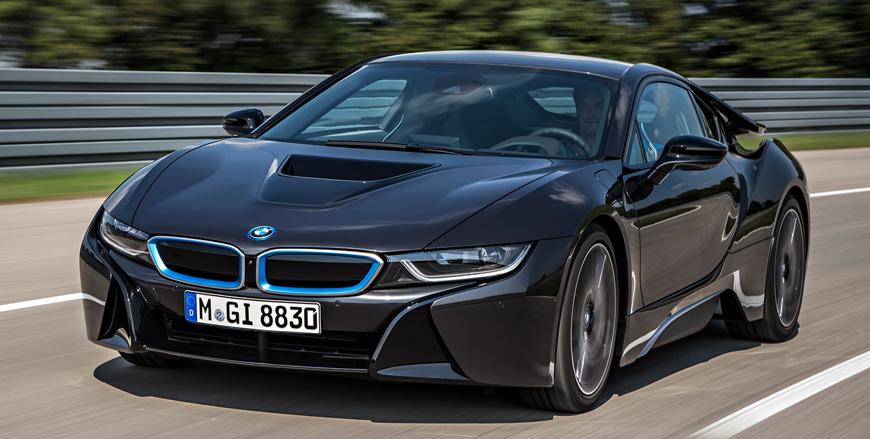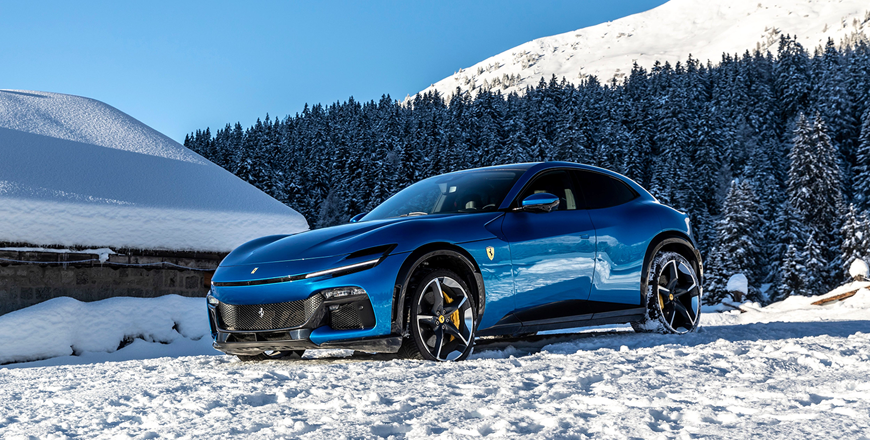You are here
BMW i8: Space-age sports car
By Ghaith Madadha - Oct 20,2016 - Last updated at Oct 21,2016

Photo courtesy of BMW
The first mid-engine BMW since the M1 sports car of 1978, the BMW i8 was first glimpsed as the Vision Efficient Dynamics concept in 2009, before production launched five years after. Like the M1 was the first fully fledged product from the Bavarian automaker’s performance M division, the i8 is the specialised electric and hybrid BMW i sub-brand’s first production car since being founded in 2011.
A luxurious high-tech mid-engine 2+2 coupe, the i8 is expected to appeal to a trendy, tech-savvy, environmentally conscious and upwardly mobile clientele. In this regard it is perhaps closer to a Tesla Model S electric luxury saloon, than a McLaren P1 hybrid supercar or the original Tesla Roadster sports car, despite a shared mid-engine configuration. Conceptually, if not technologically, its exotic and leftfield appeal is loosely similar to the DeLorean DMC-12 during the early 1980s.
Aesthetics and appeal
Similar to the DeLorean’s rear-engine layout, gull-wing doors and stainless-steel construction, the BMW i8 features exotic mid-engine configuration, forward tilted up-swinging doors, and lightweight carbon-fibre and aluminium construction to off-set the heavy hybrid components and electric motors. Likewise rakish and space age in styling and aesthetic as the DeLorean, the i8’s design and familial style, however, owes more to its asymmetric M1 predecessor.
Busier than the DeLorean’s sophisticatedly clean lines and less visceral than the M1, the i8’s design is more complicated than either. At the rear, layered pillars, upright flanks and busy shapes seem particularly complex, but help achieve low CD0.26 aerodynamics for noise refinement and fuel efficiency benefits. The i8’s glasshouse profile and a similarly dramatic and urgent front demeanour — with narrow and moody squinting fascia and bonnet louvers — are, however, clearly M1-inspired.
An accessible daily use sports coupe rather than outright sports- or supercar, the i8’s technology, packaging, practicality and petrol/electric drive-train integration are well-accomplished. With mid-mounted 1.5-litre 3-cylinder petrol internal combustion engine driving rear wheels, and electric motor driving the front, the i8 is effectively a four-wheel drive car, with associated traction and road holding benefits. In default Eco Pro driving mode, it utilises both petrol and electric motors to balance performance and efficiency.
Highly developed hybrid
Highly developed, the i8’s 3-cylinder petrol engine produces 228BHP at 5,800rpm and 236lb/ft torque at 3700rpm, while its electric motor develops 129BHP and 184lb/ft. In Sport driving mode, both work in concert to produce a combined 357BHP and 420lb/ft system output. With four-wheel-drive traction and generous and immediate electric motor torque in Sport mode, the 1,560kg i8 lunges confidently off-the-line, dispatching 0-100km/h in 4.4 seconds, and is capable of 250km/h.
Underwriting the petrol engine’s output and negating low-end turbo-lag, the i8’s electric motors also shore up its stout mid-range to provide effortlessly muscular and responsive on-the-move versatility, including 3.4-second 80-120km/h acceleration. With an aggressive stereo speaker-enhanced and throbbing offbeat 3-pot growl, the i8 is at its most responsive and manic in Sport mode.
The i8, however, takes a different persona when driven in economical electric-only mode, operating smoothly and in near silence, save for a mild sci-fi like electric motor whine. Relying more on low-end torque in electric mode, the i8’s electric range is 30km, with top speed limited to 120km/h. Standard plug-in re-charging time is 2.5 hours, while in most efficient hybrid Comfort mode, the i8’s claimed range rises to 600km, during which the combustion engine also operates as an electric generator to re-charge batteries.
Smooth and sophisticated
Driven through a six-speed automatic gearbox the i8 shifts smoothly and slickly in normal driving modes, but recalibrates for a more aggressive profile in Sport mode. Holding gears longer to access full power and down-shifting early, the i8’s gearbox is best in “auto” mode when in Sport setting, as manual inputs are often over-ridden for a more consistently aggressive and responsive set-up. The i8 also features regenerative brakes to utilise kinetic energy to help charge the batteries and help reduce brake disc wear.
With stiff carbon-fibre passenger cell and aluminium sub-frame, the i8’s sophisticated double front wishbone and rear multi-link suspension better operate in terms of handling precision and ride comfort, without interference from excessive body flex. Packaged for more neutral handling characteristics, the i8’s front electric motor and mid-engine keep major weights within its big footprint for stability and balance.
Meanwhile, heavy batteries are located in the central tunnel for balanced 50:50 weighting and low centre of gravity, and with adaptive damping allow for taut cornering composure and body lean control. Smooth and pinned down, the i8 effectively puts combined power to ground and rides firm in Sport mode but more forgivingly in default mode. Rebound control is also good, but default stability control settings are somewhat over-careful through choppy corners with exaggerated vertical and lateral movements.
Accomplished ability
One of only two current four-seat mid-engine cars, the i8 is of similar weight and weighting, only slightly larger and arguably better packaged than the Lotus Evora. However, where the two diverge is in their respective characters. A viscerally charged seat of the pants old school sports car, the Evora’s chassis and steering relay fluently textured analogue connections. The i8 is. however. a more complex beast with layers of high-tech systems providing a more managed, if somewhat clinical, but nonetheless highly accomplished and capable driving experience.
A vindicating success in hybrid driveline integration the i8 is dynamically adept and balanced through corners, with tidy, refined, quick and precise electric-assisted steering. Neutral and agile handling, with mild understeer if pushed too hard in, and alternatively oversteer if driven too aggressively out of corners, the i8 is sophisticated, stable and smooth but is not — nor is it designed to be — a raw and visceral sports car.
A practical yet powerful sports car with frugal 2.1l/100km combined ful consumption and 49g/km CO2 emissions, the i8 features a luxuriously business-like and well-equipped yet unostentatious cabin. A combination of the futuristic high-tech displays and familiar switchgear, the i8’s cabin offers good front visibility and well-adjustable, supportive and alert driving position. Wide up-swinging doors provide easy access over wide and high sills, while rear seats may be confined, but are hugely practical for children or occasional larger adult use.
TECHNICAL SPECIFICATIONS
Engine: 1.5-litre, turbocharged 3 cylinders
Electric motor: Hybrid synchronous motor
Bore x stroke: 82 x 94.6mm
Compression: 9.5:1
Valve-train: 12-valve, DOHC, variable timing
Gearbox: 6-speed automatic, four-wheel drive
Gear ratios: 1st 4.459; 2nd 2.508; 3rd 1.556; 4th 1.142; 5th 0.851; 6th 0.672
Reverse/final drive: 3.185/3.683
Power – petrol engine, BHP (PS) [kW]: 228 (231) [170] @5,800rpm
Power – electric motor, BHP (PS) [kW]: 129 (131) [96]
Power, combined, BHP (PS0 [kW]: 357 (362) [266]
Torque – petrol engine, lb/ft (Nm): 236 [320] @3,700rpm
Torque – electric motor, lb/ft (Nm): 184 (250)
Torque, combined, lb/ft (Nm): 420 (570)
0-100km/h: 4.4 seconds
80-120km/h, 4th/5th: 3.4-/4 seconds
Top speed (electric only): 250km/h (120km/h)
Fuel consumption, combined: 2.1 litres/100km
Energy consumption: 11.9kWh/100km
Fuel capacity: 42-litres
Range , electric/combined: 30-37km/600km
Battery charging: 2-2.5 hours
Aerodynamic drag co-efficient: 0.26
Weight distribution, F/R; 50:50 per cent
Turning circle: 12.3 metres
Construction: Carbon-fibre passenger cell/aluminium subframe
Suspension, F/R: Double wishbone/multilink, adaptive dampers
Brakes: Ventilated discs
Tyres, F/R: 215/45R20/245/40R20
Related Articles
A high-tech replacement for the Infiniti G Sedan, the new Q50 compact premium saloon is the luxury brand’s first new offering since recently relocating to Hong Kong and reasserting itself as a global and urbane sports luxury brand.
The plug-in hybrid variant of Mercedes-Benz’ well-regarded compact executive saloon model line, the C350e seems to be the sort of hybr
Attempting to square the engineering circle traditionally separating sport cars and high-riding vehicles, luxury Super SUVs are derided by s



















